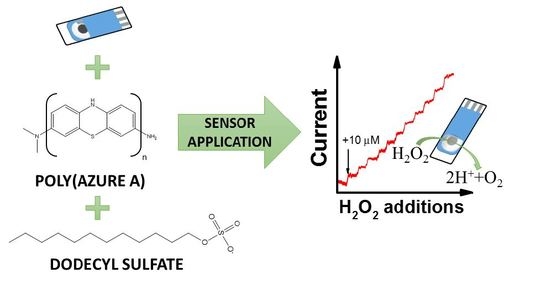A Comparative Study of Poly(Azure A) Film-Modified Disposable Electrodes for Electrocatalytic Oxidation of H2O2: Effect of Doping Anion
Abstract
:1. Introduction
2. Materials and Methods
2.1. Chemicals and Solutions
2.2. Electrosynthesis of PAA Films
2.3. Electrochemical Impedance Spectroscopy (EIS)
2.4. Electrocatalytic Oxidation of H2O2
2.5. Scanning Electron Microscopy Images
2.6. Spectroscopy
3. Results and Discussion
3.1. Electrosynthesis of PAA Films on SPCEs
3.2. Electrochemical Response
3.3. Surface Characterization
3.4. Electrochemical Impedance Spectroscopy
3.5. Electrocatalytic Activity
4. Conclusions
Supplementary Materials
Acknowledgments
Author Contributions
Conflicts of Interest
References
- Zhang, Y.; Wilson, G.S. Electrochemical oxidation of H2O2 on Pt and Pt + Ir electrodes in physiological buffer and its applicability to H2O2-based biosensors. J. Electroanal. Chem. 1993, 345, 253–271. [Google Scholar] [CrossRef]
- Gonzalez-Sanchez, M.I.; Gonzalez-Macia, L.; Perez-Prior, M.T.; Valero, E.; Hancock, J.; Killard, A.J. Electrochemical detection of extracellular hydrogen peroxide in Arabidopsis thaliana: A real-time marker of oxidative stress. Plant Cell Environ. 2013, 36, 869–878. [Google Scholar] [CrossRef] [PubMed]
- Agrisuelas, J.; Garcia-Jareño, J.J.; Rivas, P.; Rodriguez-Mellado, J.M.; Vicente, F. Electrochemistry and electrocatalysis of a Pt@poly(neutral red) hybrid nanocomposite. Electrochim. Acta 2015, 171, 165–175. [Google Scholar] [CrossRef]
- Agrisuelas, J.; Gonzalez-Sanchez, M.-I.; Valero, E. Hydrogen peroxide sensor based on in situ grown Pt nanoparticles from waste screen-printed electrodes. Sens. Actuators B Chem. 2017, 249, 499–505. [Google Scholar] [CrossRef]
- Miao, P.; Wang, B.; Yin, J.; Chen, X.; Tang, Y. Electrochemical tracking hydrogen peroxide secretion in live cells based on autocatalytic oxidation reaction of silver nanoparticles. Electrochem. Commun. 2015, 53, 37–40. [Google Scholar] [CrossRef]
- Wang, Y.; Wang, Z.; Rui, Y.; Li, M. Horseradish peroxidase immobilization on carbon nanodots/CoFe layered double hydroxides: Direct electrochemistry and hydrogen peroxide sensing. Biosens. Bioelectron. 2015, 64, 57–62. [Google Scholar] [CrossRef] [PubMed]
- Janata, J.; Josowicz, M. Conducting polymers in electronic chemical sensors. Nat. Mater. 2003, 2, 19–24. [Google Scholar] [CrossRef] [PubMed]
- Omar, F.S.; Duraisamy, N.; Ramesh, K.; Ramesh, S. Conducting polymer and its composite materials based electrochemical sensor for Nicotinamide Adenine Dinucleotide (NADH). Biosens. Bioelectron. 2016, 79, 763–775. [Google Scholar] [CrossRef] [PubMed]
- González-Sánchez, M.I.; Laurenti, M.; Rubio-Retama, J.; Valero, E.; Lopez-Cabarcos, E. Fluorescence Decrease of Conjugated Polymers by the Catalytic Activity of Horseradish Peroxidase and Its Application in Phenolic Compounds Detection. Biomacromolecules 2011, 12, 1332–1338. [Google Scholar] [CrossRef] [PubMed]
- González-Sánchez, M.-I.; Laurenti, M.; Rubio-Retama, J.; López-Cabarcos, E.; Valero, E. Searching for the fluorescence quenching mechanism of conjugated polymers by cytochrome c. Colloids Surf. A Physicochem. Eng. Asp. 2016, 510, 300–308. [Google Scholar] [CrossRef]
- Yano, J.; Kobayashi, M.; Yamasaki, S.; Harima, Y.; Yamashita, K. Mean redox potentials of polyaniline determined by chronocoulometry. Synth. Met. 2001, 119, 315–316. [Google Scholar] [CrossRef]
- Elmansouri, A.; Outzourhit, A.; Lachkar, A.; Hadik, N.; Abouelaoualim, A.; Achour, M.E.; Oueriagli, A.; Ameziane, E.L. Influence of the counter ion on the properties of poly(o-toluidine) thin films and their Schottky diodes. Synth. Met. 2009, 159, 292–297. [Google Scholar] [CrossRef]
- Mohamoud, M.A.; Hillman, A.R. The effect of anion identity on the viscoelastic properties of polyaniline films during electrochemical film deposition and redox cycling. Electrochim. Acta 2007, 53, 1206–1216. [Google Scholar] [CrossRef]
- Vidal, J.-C.; Garcia-Ruiz, E.; Castillo, J.-R. Recent Advances in Electropolymerized Conducting Polymers in Amperometric Biosensors. Microchim. Acta 2003, 143, 93–111. [Google Scholar] [CrossRef]
- Silk, T.; Hong, Q.; Tamm, J.; Compton, R.G. AFM studies of polypyrrole film surface morphology I. The influence of film thickness and dopant nature. Synth. Met. 1998, 93, 59–64. [Google Scholar] [CrossRef]
- Windmiller, J.R.; Wang, J. Wearable Electrochemical Sensors and Biosensors: A Review. Electroanalysis 2013, 25, 29–46. [Google Scholar] [CrossRef]
- Lezi, N.; Economou, A.; Barek, J.; Prodromidis, M. Screen-Printed Disposable Sensors Modified with Bismuth Precursors for Rapid Voltammetric Determination of 3 Ecotoxic Nitrophenols. Electroanalysis 2014, 26, 766–775. [Google Scholar] [CrossRef]
- Michopoulos, A.; Florou, A.B.; Prodromidis, M.I. Ultrasensitive Determination of Vitamin B12 Using Disposable Graphite Screen-Printed Electrodes and Anodic Adsorptive Voltammetry. Electroanalysis 2015, 27, 1876–1882. [Google Scholar] [CrossRef]
- González-Sánchez, M.I.; Lee, P.T.; Guy, R.H.; Compton, R.G. In situ detection of salicylate in Ocimum basilicum plant leaves via reverse iontophoresis. Chem. Commun. 2015, 51, 16534–16536. [Google Scholar] [CrossRef] [PubMed] [Green Version]
- González-Sánchez, M.I.; Valero, E.; Compton, R.G. Iodine mediated electrochemical detection of thiols in plant extracts using platinum screen-printed electrodes. Sens. Actuators B Chem. 2016, 236, 1–7. [Google Scholar] [CrossRef]
- Karyakin, A.A.; Karyakina, E.E.; Schmidt, H.-L. Electropolymerized Azines: A New Group of Electroactive Polymers. Electroanalysis 1999, 11, 149–155. [Google Scholar] [CrossRef]
- Agrisuelas, J.; Gabrielli, C.; García-Jareño, J.J.; Gimenez-Romero, D.; Perrot, H.; Vicente, F. Spectroelectrochemical identification of the active sites for protons and anions insertions into poly(Azure A) thin polymer films. J. Phys. Chem. C 2007, 111, 14230–14237. [Google Scholar] [CrossRef]
- Agrisuelas, J.; Gabrielli, C.; Garcia-Jareno, J.J.; Perrot, H.; Vicente, F. Ionic and Free Solvent Motion in Poly(azure A) Studied by ac-Electrogravimetry. J. Phys. Chem. C 2011, 115, 11132–11139. [Google Scholar] [CrossRef]
- Gao, Q.; Cui, X.; Yang, F.; Ma, Y.; Yang, X. Preparation of poly(thionine) modified screen-printed carbon electrode and its application to determine NADH in flow injection analysis system. Biosens. Bioelectron. 2003, 19, 277–282. [Google Scholar] [CrossRef]
- Gao, Q.; Wang, W.D.; Ma, Y.; Yang, X.R. Electrooxidative polymerization of phenothiazine derivatives on screen-printed carbon electrode and its application to determine NADH in flow injection analysis system. Talanta 2004, 62, 477–482. [Google Scholar] [CrossRef] [PubMed]
- Sahin, M.; Ayranci, E. Electrooxidation of NADH on Modified Screen-Printed Electrodes: Effects of Conducting Polymer and Nanomaterials. Electrochim. Acta 2015, 166, 261–270. [Google Scholar] [CrossRef]
- Agrisuelas, J.; González-Sánchez, M.-I.; Valero, E. Electrochemical Properties of Poly(Azure A) Films Synthesized in Sodium Dodecyl Sulfate Solution. J. Electrochem. Soc. 2017, 164, G1–G9. [Google Scholar] [CrossRef]
- Gay, C.; Collins, J.; Gebicki, J.M. Hydroperoxide Assay with the Ferric–Xylenol Orange Complex. Anal. Biochem. 1999, 273, 149–155. [Google Scholar] [CrossRef] [PubMed]
- Bondarenko, A.S.; Ragoisha, G.A. Inverse Problem In Potentiodynamic Electrochemical Impedance. In Progress in Chemometrics Research; Pomerantsev, A.L., Ed.; Nova Science Publishers: New York, NY, USA, 2005; pp. 89–102. ISBN 1-59454-257-0. [Google Scholar]
- Kamata, K.; Suzuki, T.; Kawai, T.; Iyoda, T. Voltammetric anion recognition by a highly cross-linked polyviologen film. J. Electroanal. Chem. 1999, 473, 145–155. [Google Scholar] [CrossRef]
- Naoi, K.; Lien, M.; Smyrl, W.H. Quartz Crystal Microbalance Study: Ionic Motion across Conducting Polymers. J. Electrochem. Soc. 1991, 138, 440–445. [Google Scholar] [CrossRef]
- Ramkumar, R.; Sundaram, M.M. Electrochemical synthesis of polyaniline cross-linked NiMoO4 nanofibre dendrites for energy storage devices. New J. Chem. 2016, 40, 7456–7464. [Google Scholar] [CrossRef]
- Shan, D.; Mu, S.L.; Mao, B.W. Detection of intermediate during the electrochemical polymerization of azure B and growth of poly(Azure B) film. Electroanalysis 2001, 13, 493–498. [Google Scholar] [CrossRef]
- Agrisuelas, J.; Giménez-Romero, D.; García-Jareño, J.J.; Vicente, F. Vis/NIR spectroelectrochemical analysis of poly-(Azure A) on ITO electrode. Electrochem. Commun. 2006, 8, 549–553. [Google Scholar] [CrossRef]
- Pauliukaite, R.; Brett, C.M.A. Poly(neutral red): Electrosynthesis, Characterization, and Application as a Redox Mediator. Electroanalysis 2008, 20, 1275–1285. [Google Scholar] [CrossRef]
- Peng, Z.; Guo, L.; Zhang, Z.; Tesche, B.; Wilke, T.; Ogermann, D.; Hu, S.; Kleinermanns, K. Micelle-assisted one-pot synthesis of water-soluble polyaniline-gold composite particles. Langmuir 2006, 22, 10915–10918. [Google Scholar] [CrossRef] [PubMed]
- Yang, C.; Zhao, J.; Xu, J.; Hu, C.; Hu, S. A highly sensitive electrochemical method for the determination of Sudan I at polyvinylpyrrolidone modified acetylene black paste electrode based on enhancement effect of sodium dodecyl sulphate. Int. J. Environ. Anal. Chem. 2009, 89, 233–244. [Google Scholar] [CrossRef]
- Deng, P.; Feng, Y.; Fei, J. A new electrochemical method for the determination of trace molybdenum(VI) using carbon paste electrode modified with sodium dodecyl sulfate. J. Electroanal. Chem. 2011, 661, 367–373. [Google Scholar] [CrossRef]
- Gabrielli, C.; Takenouti, H.; Haas, O.; Tsukada, A. Impedance investigation of the charge transport in film-modified electrodes. J. Electroanal. Chem. Interfacial Electrochem. 1991, 302, 59–89. [Google Scholar] [CrossRef]
- Presa, M.J.R.; Tucceri, R.I.; Florit, M.I.; Posadas, D. Constant phase element behavior in the poly(o-toluidine) impedance response. J. Electroanal. Chem. 2001, 502, 82–90. [Google Scholar] [CrossRef]
- Nowicka, A.M.; Fau, M.; Rapecki, T.; Donten, M. Polypyrrole-Au Nanoparticles Composite as Suitable Platform for DNA Biosensor with Electrochemical Impedance Spectroscopy Detection. Electrochim. Acta 2014, 140, 65–71. [Google Scholar] [CrossRef]
- Inagi, S.; Fuchigami, T. Electrochemical Post-Functionalization of Conducting Polymers. Macromol. Rapid Commun. 2014, 35, 854–867. [Google Scholar] [CrossRef] [PubMed]
- Lin, Y.-C.; Hsu, F.-H.; Wu, T.-M. Enhanced conductivity and thermal stability of conductive polyaniline/graphene composite synthesized by in situ chemical oxidation polymerization with sodium dodecyl sulfate. Synth. Met. 2013, 184, 29–34. [Google Scholar] [CrossRef]
- Lin, K.C.; Lin, Y.C.; Chen, S.M. Electrocatalytic reaction of hydrogen peroxide and NADH based on poly(neutral red) and FAD hybrid film. Analyst 2012, 137, 186–194. [Google Scholar] [CrossRef] [PubMed]
- Baskar, S.; Chang, J.-L.; Zen, J.-M. Simultaneous detection of NADH and H2O2 using flow injection analysis based on a bifunctional poly(thionine)-modified electrode. Biosens. Bioelectron. 2012, 33, 95–99. [Google Scholar] [CrossRef] [PubMed]
- Chen, C.; Hong, X.; Xu, T.; Chen, A.; Lu, L.; Gao, Y. Electrocatalytic Oxidation and Determination of Hydrogen Peroxide at Poly(N-methylthionine) Electrodes. J. Electrochem. Soc. 2015, 162, H699–H702. [Google Scholar] [CrossRef]
- Gegiou, D.; Huber, J.R.; Weiss, K. Photochemistry of phenoxazine. Flash-photolytic study. J. Am. Chem. Soc. 1970, 92, 5058–5062. [Google Scholar] [CrossRef]
- Agrisuelas, J.; Gabrielli, C.; García-Jareño, J.J.; Perrot, H.; Sanchis-Gual, R.; Sel, O.; Vicente, F. Evaluation of the electrochemical anion recognition of NO3−-imprinted poly(Azure A) in mixed solutions by ac-electrogravimetry. Electrochim. Acta 2016, 194, 292–303. [Google Scholar] [CrossRef]
- Liu, T.; Luo, Y.; Wang, W.; Kong, L.; Zhu, J.; Tan, L. Non-enzymatic detection of hydrogen peroxide based on Fenton-type reaction on poly(azure A)-chitosan/Cu modified electrode. Electrochim. Acta 2015, 182, 742–750. [Google Scholar] [CrossRef]
- Lin, K.C.; Vilian, A.T.E.; Chen, S.M. Using multi-walled carbon nanotubes to enhance coimmobilization of poly(azure A) and poly(neutral red) for determination of nicotinamide adenine dinucleotide and hydrogen peroxide. RSC Adv. 2014, 4, 45566–45574. [Google Scholar] [CrossRef]
- Cinti, S.; Arduini, F.; Moscone, D.; Palleschi, G.; Killard, A.J. Development of a Hydrogen Peroxide Sensor Based on Screen-Printed Electrodes Modified with Inkjet-Printed Prussian Blue Nanoparticles. Sensors 2014, 14, 14222–14234. [Google Scholar] [CrossRef] [PubMed]
- Lin, K.-C.; Yin, C.-Y.; Chen, S.-M. An electrochemical biosensor for determination of hydrogen peroxide using nanocomposite of poly(methylene blue) and FAD hybrid film. Sens. Actuators B Chem. 2011, 157, 202–210. [Google Scholar] [CrossRef]
- Gonçalves, A.R.; Ghica, M.E.; Brett, C.M.A. Preparation and characterisation of poly(3,4-ethylenedioxythiophene) and poly(3,4-ethylenedioxythiophene)/poly(neutral red) modified carbon film electrodes, and application as sensors for hydrogen peroxide. Electrochim. Acta 2011, 56, 3685–3692. [Google Scholar] [CrossRef]
- Han, J.; Ma, J.; Ma, Z. One-step synthesis of poly(thionine)-Au nano-network and nanowires and its application for non-enzyme biosensing of hydrogen peroxide. Electrochem. Commun. 2013, 33, 47–50. [Google Scholar] [CrossRef]
- Liu, H.-J.; Yang, D.-W.; Liu, H.-H. A hydrogen peroxide sensor based on the nanocomposites of poly(brilliant cresyl blue) and single walled-carbon nanotubes. Anal. Methods 2012, 4, 1421–1426. [Google Scholar] [CrossRef]
- González-Sánchez, M.I.; Agrisuelas, J.; Valero, E.; Compton, R.G. Measurement of Total Antioxidant Capacity by Electrogenerated Iodine at Disposable Screen Printed Electrodes. Electroanalysis 2017, 29, 1316–1323. [Google Scholar] [CrossRef]
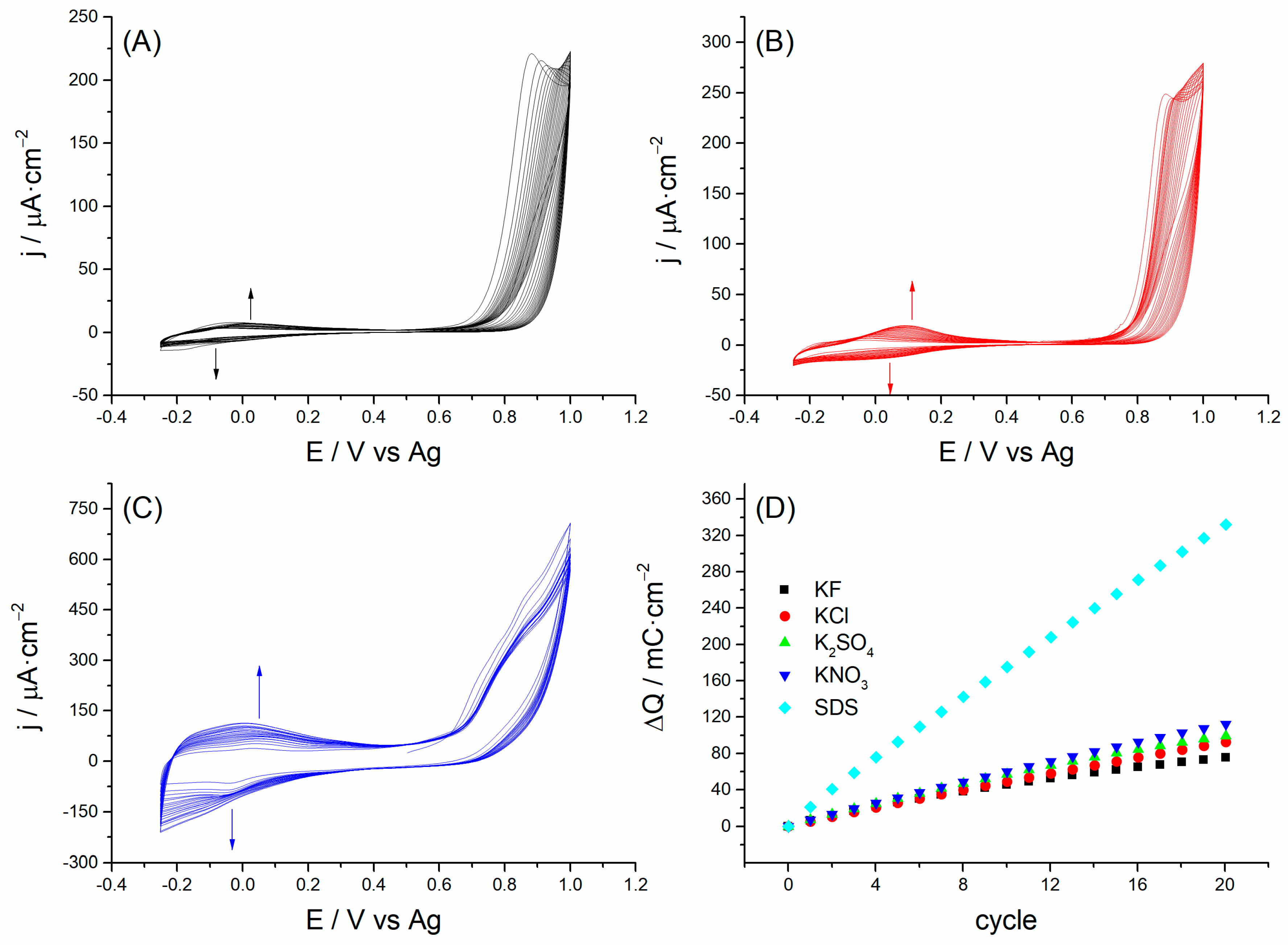
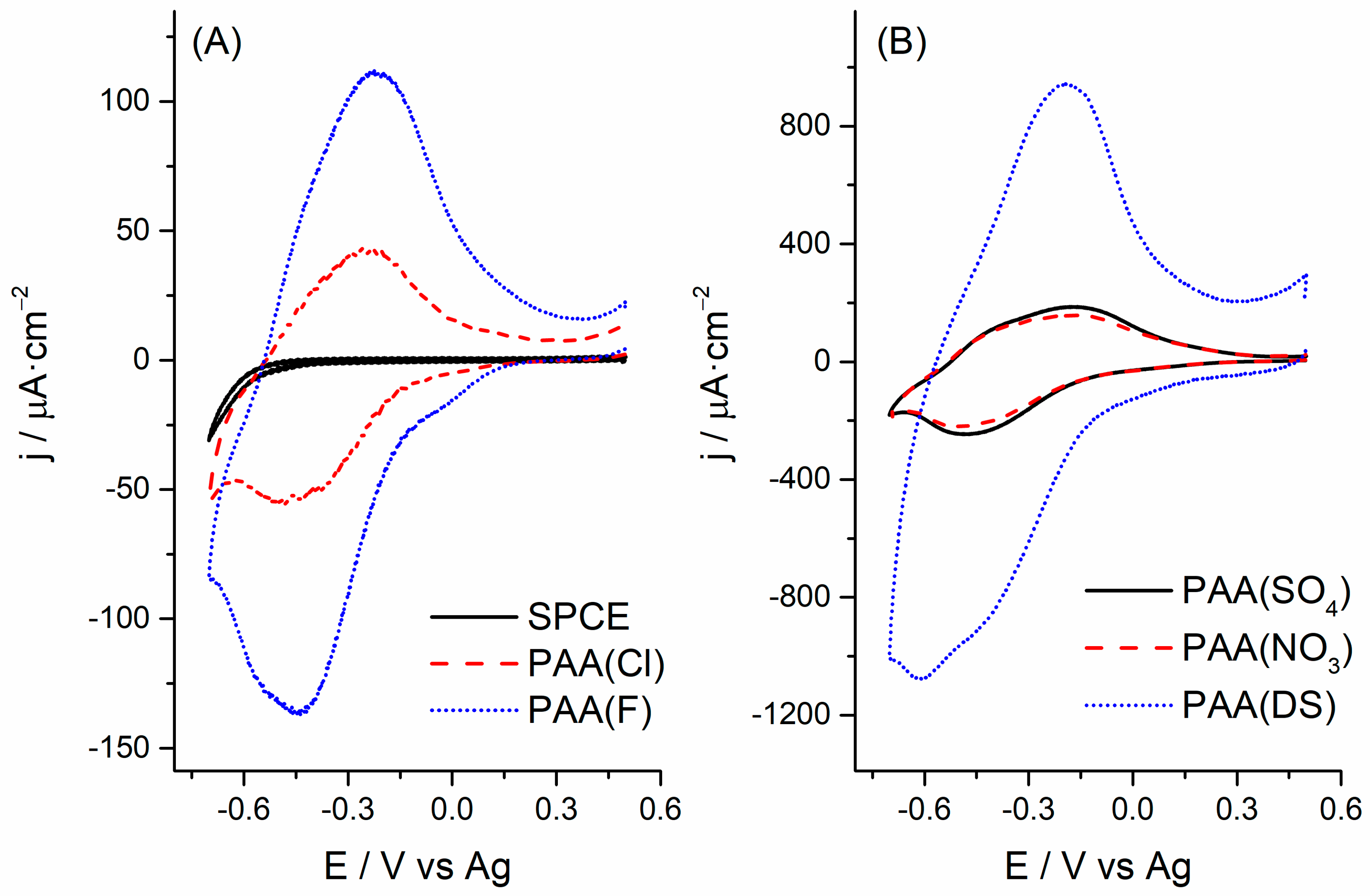
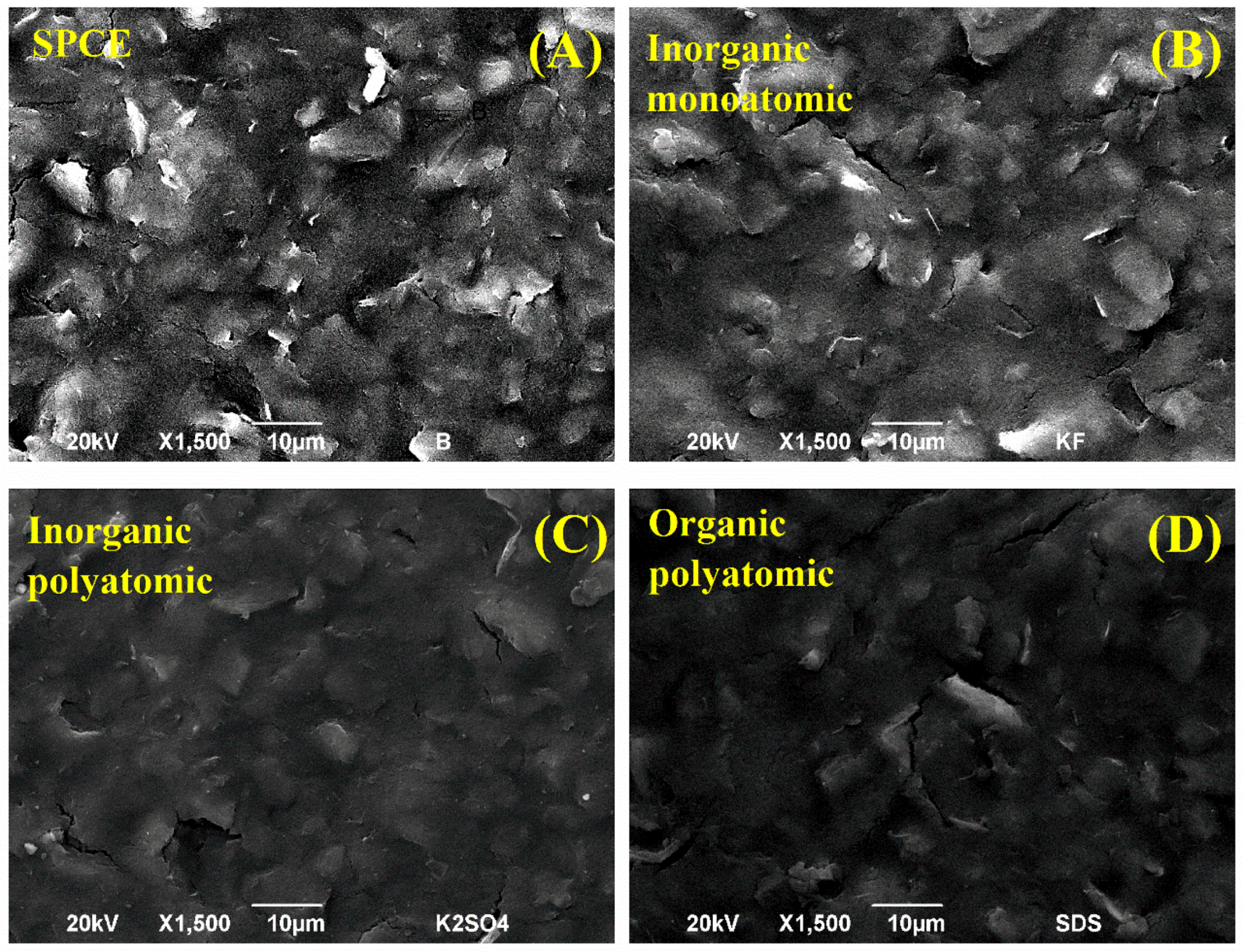
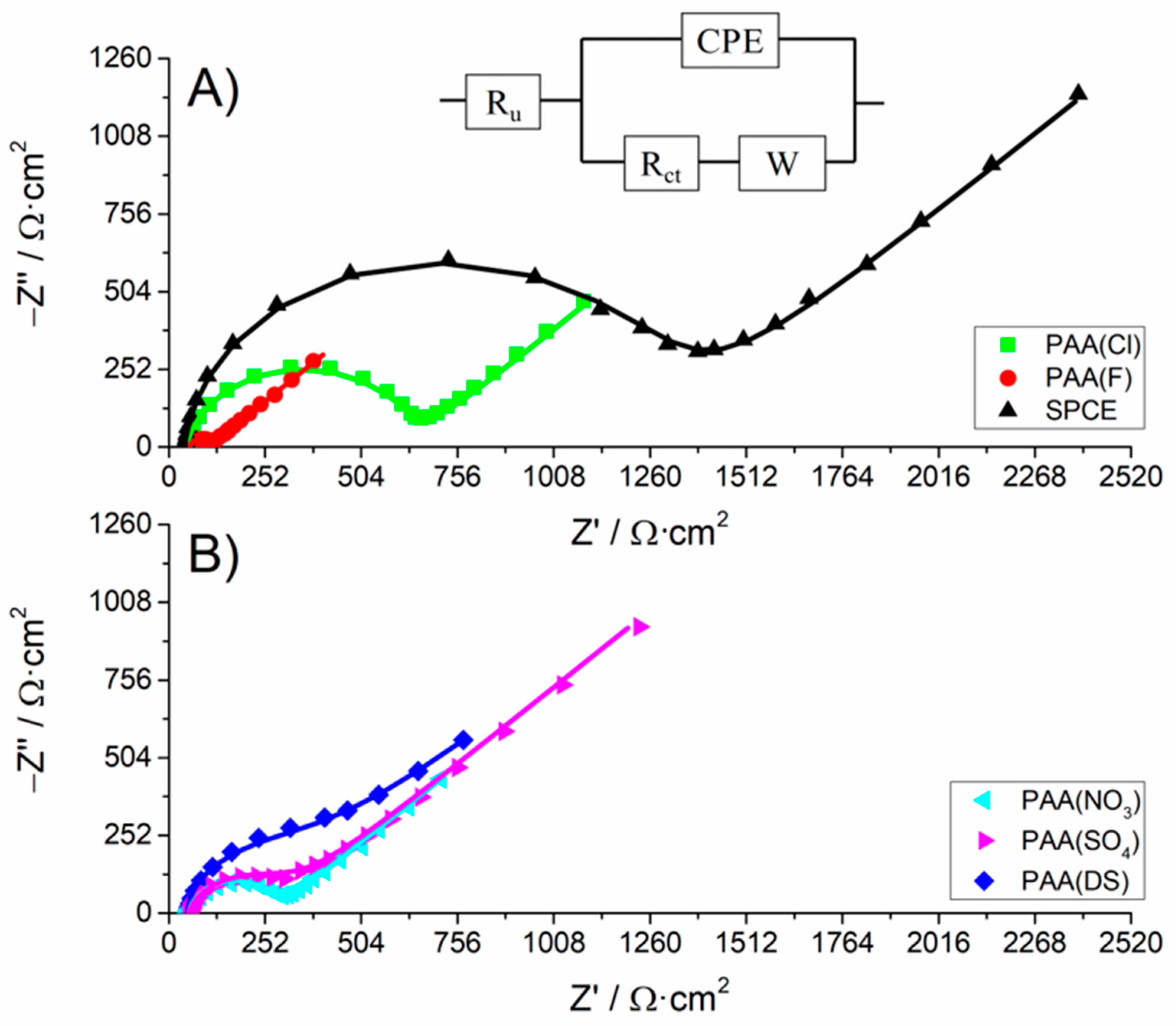
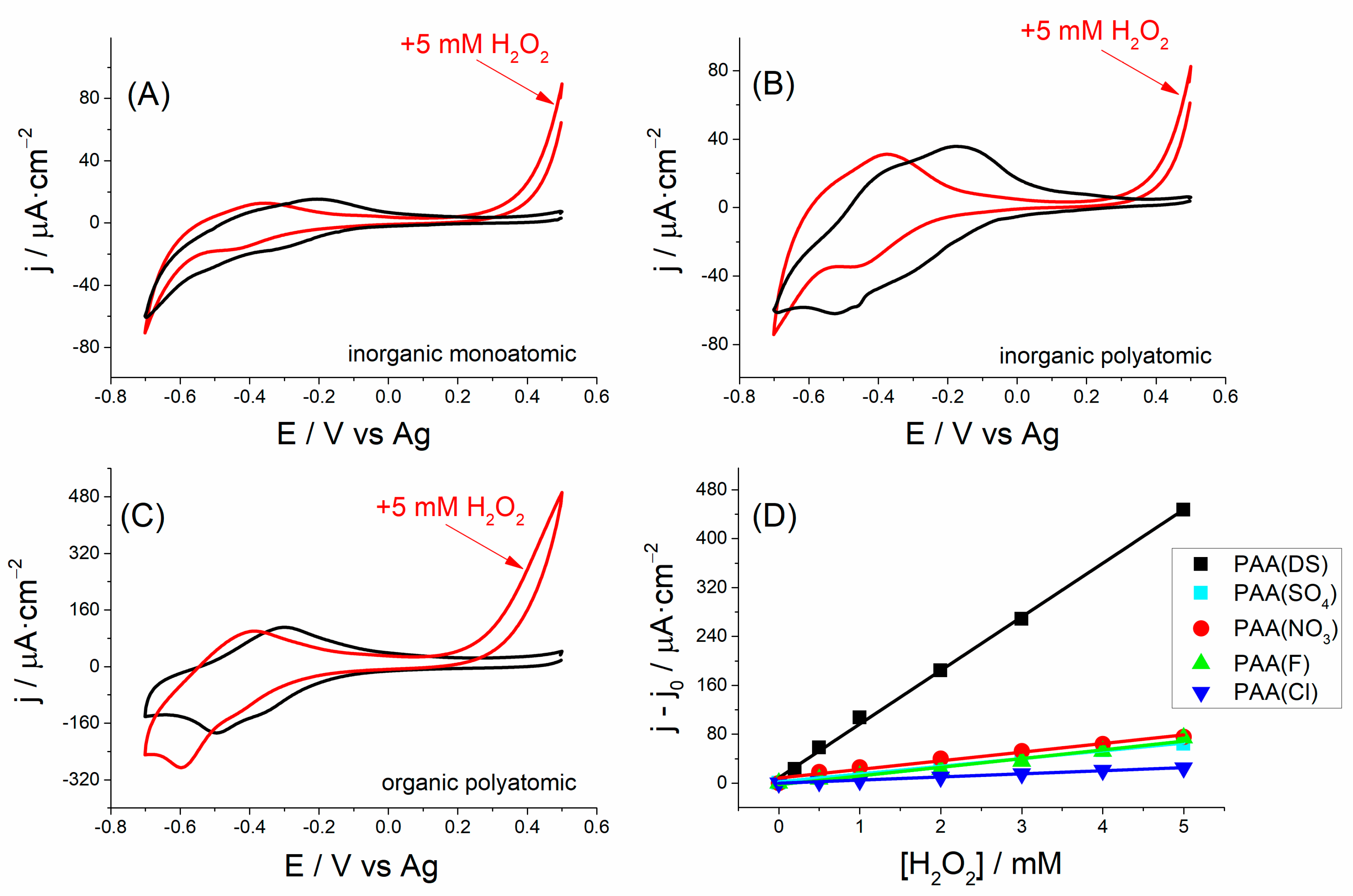
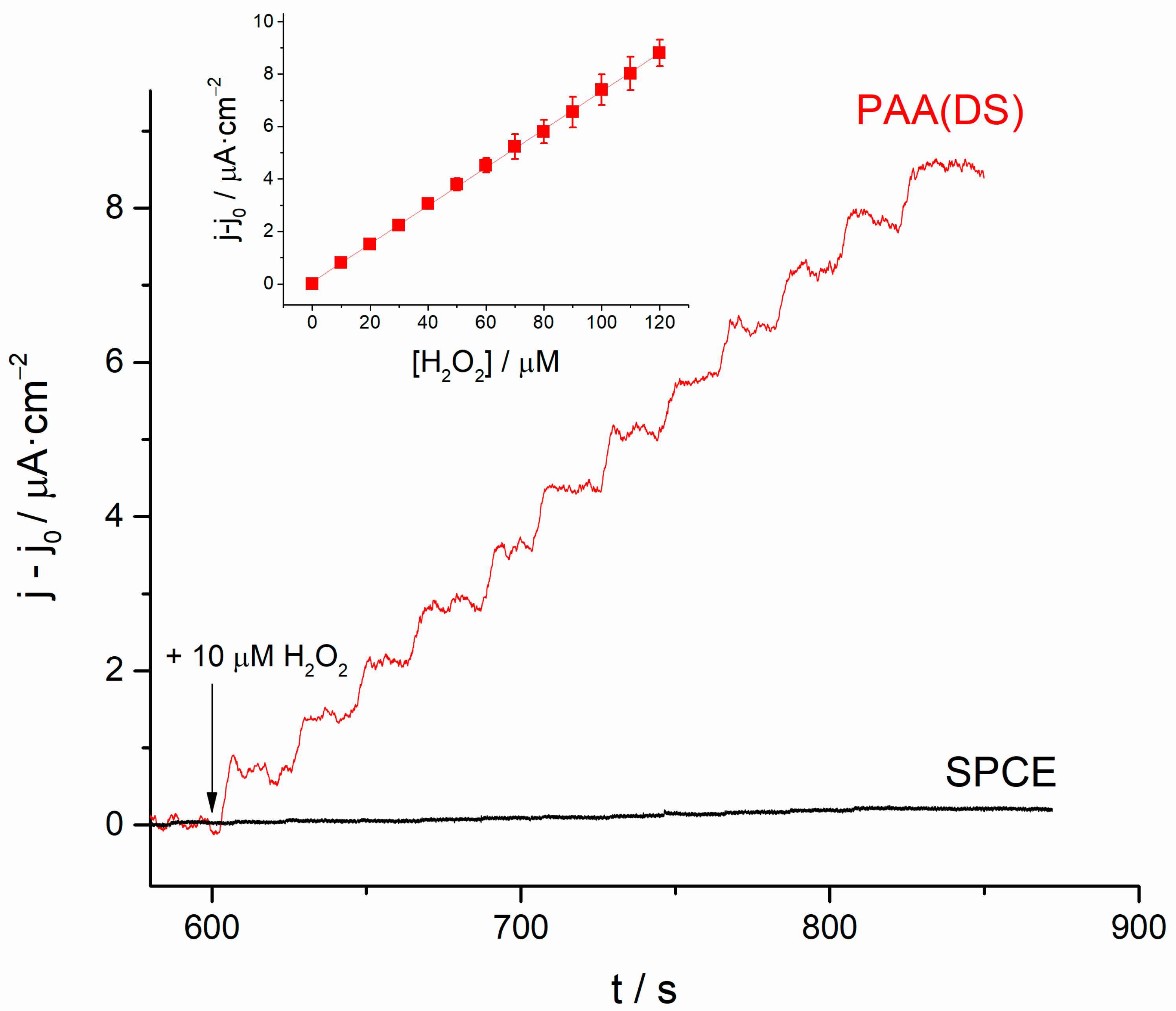
| Electrode | Ω·cm2 | CPE μF·cm−2 | Ω·cm2 | Ω·cm2·s−0.5 | |
|---|---|---|---|---|---|
| SPCE | 42 | 33 | 0.9 | 1233 | 279 |
| PAA(Cl) | 46 | 29 | 0.9 | 585 | 115 |
| PAA(F) | 56 | 29 | 1.0 | 49 | 75 |
| PAA(NO3) | 52 | 56 | 0.9 | 227 | 110 |
| PAA(SO4) | 52 | 140 | 0.9 | 254 | 232 |
| PAA(DS) | 50 | 1900 | 1.0 | 292 | 132 |
| Electrode a | E (V) | Reference Electrode | LOD (μM) | Sensitivity (nA·μM−1·cm−2) | Reference |
|---|---|---|---|---|---|
| Pt foil|PNMTh | 0.60 | SCE | 0.1 | 2786.0 | [46] |
| GCE|PAA-CS|Cu | −0.40 | SCE | 0.7 | 88.9 | [49] |
| PAA-PNR|MWCNTs | −0.25 | Ag/AgCl | 1.0 | 10.3 | [50] |
| SPCE|PBNPs | 0.00 | Ag/AgCl b | 0.2 | 762.0 | [51] |
| GCE|PMB-FAD | −0.45 | Ag/AgCl | 0.1 | 1109.0 | [52] |
| CF|PEDOT-PNR | −0.36 | SCE | 80 | 0.9 | [53] |
| GCE|PTH-Au | −0.10 | Ag/AgCl | 0.2 | 14.1 | [54] |
| GCE|PBCB|SWCNT | −0.30 | SCE | 120.0 | 58.1 | [55] |
| PAA(DS)|SPCE | 0.50 | Ag | 1.4 | 72.4 | This work |
| Sample a | Electrochemical Method (M) | Spectrophotometric Method (M) | Recovery (%) |
|---|---|---|---|
| Hair lightener | 1.20 ± 0.01 | 1.19 ± 0.04 | 100.8 |
| Antiseptic | 0.84 ± 0.02 | 0.85 ± 0.04 | 98.9 |
© 2018 by the authors. Licensee MDPI, Basel, Switzerland. This article is an open access article distributed under the terms and conditions of the Creative Commons Attribution (CC BY) license (http://creativecommons.org/licenses/by/4.0/).
Share and Cite
Agrisuelas, J.; González-Sánchez, M.-I.; Gómez-Monedero, B.; Valero, E. A Comparative Study of Poly(Azure A) Film-Modified Disposable Electrodes for Electrocatalytic Oxidation of H2O2: Effect of Doping Anion. Polymers 2018, 10, 48. https://doi.org/10.3390/polym10010048
Agrisuelas J, González-Sánchez M-I, Gómez-Monedero B, Valero E. A Comparative Study of Poly(Azure A) Film-Modified Disposable Electrodes for Electrocatalytic Oxidation of H2O2: Effect of Doping Anion. Polymers. 2018; 10(1):48. https://doi.org/10.3390/polym10010048
Chicago/Turabian StyleAgrisuelas, Jerónimo, María-Isabel González-Sánchez, Beatriz Gómez-Monedero, and Edelmira Valero. 2018. "A Comparative Study of Poly(Azure A) Film-Modified Disposable Electrodes for Electrocatalytic Oxidation of H2O2: Effect of Doping Anion" Polymers 10, no. 1: 48. https://doi.org/10.3390/polym10010048




